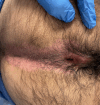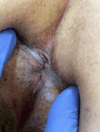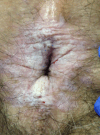Anal pruritus: Don't look away
- PMID: 38577644
- PMCID: PMC10989252
- DOI: 10.4253/wjge.v16.i3.112
Anal pruritus: Don't look away
Abstract
Anal pruritus is a common anorectal symptom that can significantly impair a patient's quality of life, including their mental health. It can be one of the most difficult proctological conditions to treat. Patients often delay seeking medical attention, since it is an embarrassing but non-life-threatening situation. Pruritus ani can be associated with idiopathic and secondary causes, such as anorectal diseases, cancer (anal or colorectal), dermatological and sexually transmitted diseases, fungal infections and systemic diseases. If patients are referred for a colonoscopy, this can sometimes provide the first opportunity to evaluate the perianal area. Classifications of anal pruritus are based on the abnormalities of the perianal skin, one of the most commonly used being the Washington classification. A proper digital anorectal examination is important, as well as an anoscopy to help to exclude anorectal diseases or suspicious masses. Endoscopists should be aware of the common etiologies, and classification of the perianal area abnormalities should be provided in the colonoscopy report. Information on treatment possibilities and follow-up can also be provided. The treatment normally consists of a triple approach: proper hygiene, elimination of irritants, and skin care and protection. Several topical therapies have been described as possible treatments, including steroids, capsaicin, tacrolimus and methylene blue intradermal injections.
Keywords: Anal pruritus; Cancer; Colonoscopy; Fissure; Hemorrhoids; Washington classification.
©The Author(s) 2024. Published by Baishideng Publishing Group Inc. All rights reserved.
Conflict of interest statement
Conflict-of-interest statement: All authors have no conflicts of interest to disclose.
Figures




References
Publication types
LinkOut - more resources
Full Text Sources

